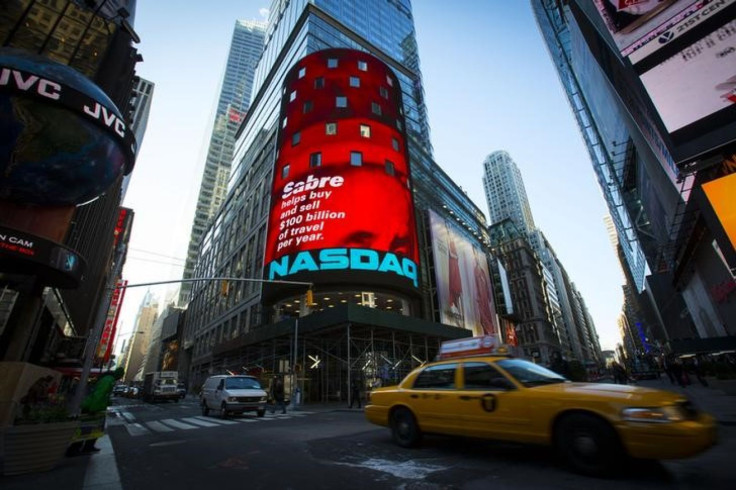Nasdaq Composite Dips, But Edges Closer To All-Time Closing High

U.S. stocks closed slightly lower Monday as a dip in the dollar and ongoing Greek bailout negotiations muted early gains. Investors also weighed a speech from a top Federal Reserve official that revealed an interest rate hike from the central bank could happen by the end of 2015.
Although the Nasdaq composite finished Monday in the red, the index still closed above the psychologically important 5,000 milestone for the third time this year, and only the fifth time ever. The first time the Nasdaq closed above 5,000 was during the dot-com bubble in 2000.
The Dow (INDEXDJX:.DJI), which measures the share prices of 30 large industrial companies, lost 11.61 points, or 0.06 percent, to close at 18,116.04. The Standard & Poor's 500 (INDEXNASDAQ:.IXIC) dipped 3.68 points, or 0.17 percent, to end at 2,104.42.
The Nasdaq composite (INDEXSP:.INX) fell 15.44 points, or 0.31 percent, to finish at 5,010.97. The declines Monday were driven by losses in the Nasdaq's biotechnology sector, which snapped a nine-session rally and fell more than 2 percent.
The index would need to close above 5,048.62 to break its all-time closing high set on March 10, 2000.
Ahead on the economic calendar, the Consumer Price Index (CPI), which measures the average prices of consumer goods and services, such as transportation, food and medical care, is scheduled to be released Tuesday. Economists expect CPI to rise 0.2 percent last month after declining 0.7 percent in January. CPI, which the U.S. Federal Reserve uses to gauge inflation, posted its largest drop since 2008 in January, weighed down by the precipitous drop in gasoline prices.
Federal Reserve Vice Chair Stanley Fischer said Monday during remarks to the Economic Club of New York that a rise in interest rates “likely will be warranted before the end of the year." However, Fischer said the central bank’s pace of interest-rate hikes will be less predictable after liftoff as the Fed will take into account “shocks we have to deal with” within the U.S. economy, such as the uncertain direction of oil prices.
The statement comes after Atlanta Federal Reserve President Dennis Lockhart said Friday he expects the central bank to raise interest rates at either its June, July or September policy meetings. Both Lockhart and Fischer are voting members this year on the Federal Open Market Committee, the central bank's board that determines the direction of monetary policy.
Market professionals are analyzing comments from policy officials after the Fed opened the door to hiking rates as early as June following its meeting last week. However, Fed Chair Janet Yellen stressed the central bank’s decisions will be “data-dependent,” meaning the FOMC will need to see continued improvement in the labor market and inflation readings before hiking rates.
Inflation has remained weaker than anticipated, largely due to the drop in energy prices since June and muted wage growth. However, the Fed suggested it wants to remain on hold before hiking rates as slack in the labor market continues to diminish. “The Fed seems very willing to adjust the goal posts as they need to in order to hit their goal of keeping the U.S. economy growing strongly enough so that inflation rebounds firmly,” said Chris Faulkner-MacDonagh, global markets strategist at Standard Life Investments.
U.S. dollar index, which measures the value of the greenback against a basket of major currencies, including the euro, Japanese yen, Canadian dollar, British pound, Swedish krona and Swiss franc, fell more than 0.8 percent to $96.94. The dollar’s dip comes after the greenback surged to a 12-year high against the euro earlier this month. The euro rose more than 1 percent to $1.09 against the greenback Monday, after falling below $1.05 on March 12 for the first time since January 2003.
Crude oil rose near $56 a barrel Monday after a dip in the U.S. dollar offset concerns that Saudi Arabia’s oil output rose to a near-record high of 10 million barrels per day. Brent crude, the benchmark for global oil prices, rose 60 cents, to close at $55.90 a barrel, for April 15 delivery on the London ICE Futures Exchange. West Texas Intermediate crude, the benchmark for U.S. oil prices, added 88 cents, to close at $47.45 a barrel, for April 15 delivery on the New York Mercantile Exchange.
© Copyright IBTimes 2024. All rights reserved.




















